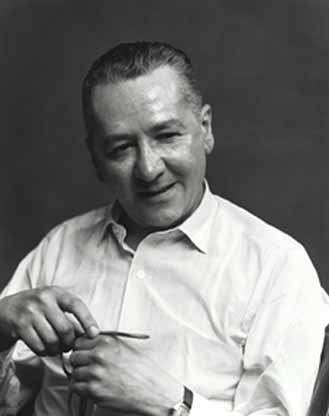WILLIAM BAZIOTES (1912 - 1963)
 William Baziotes was an American painter known for his luminous abstractions of biomorphic forms. Though he is considered an Abstract Expressionist, Baziotes’s work remained outside the dominant aspects of the movement. His paintings are in many ways more closely aligned with the early Surrealist works of Mark Rothko, Adolph Gottlieb, and Robert Motherwell. “It is the mysterious that I love in painting,” he once reflected. “It is the stillness and the silence. I want my pictures to take effect very slowly, to obsess and to haunt.” Born on June 11, 1912 in Pittsburgh, PA, he was raised in the town of Reading, PA, where he worked antiquing glass as a young man. Interested in the poetry of Charles Baudelaire and the paintings of Henri Matisse, Baziotes moved to New York in 1933 to attend the National Academy of Design. During the late 1930s, the artist worked for the WPA Federal Art Project, both as a teacher and in its easel division. He was introduced to Motherwell by the Surrealist painter Roberto Matta in 1941, and had his first solo exhibition at Peggy Guggenheim’s gallery Art of This Century in 1944. The artist died on June 6, 1963 in New York, NY. Today, his works are held in the collections of Solomon R. Guggenheim Museum in New York, the Walker Art Center in Minneapolis, and the National Gallery of Art in Washington, D.C., among others.
William Baziotes was an American painter known for his luminous abstractions of biomorphic forms. Though he is considered an Abstract Expressionist, Baziotes’s work remained outside the dominant aspects of the movement. His paintings are in many ways more closely aligned with the early Surrealist works of Mark Rothko, Adolph Gottlieb, and Robert Motherwell. “It is the mysterious that I love in painting,” he once reflected. “It is the stillness and the silence. I want my pictures to take effect very slowly, to obsess and to haunt.” Born on June 11, 1912 in Pittsburgh, PA, he was raised in the town of Reading, PA, where he worked antiquing glass as a young man. Interested in the poetry of Charles Baudelaire and the paintings of Henri Matisse, Baziotes moved to New York in 1933 to attend the National Academy of Design. During the late 1930s, the artist worked for the WPA Federal Art Project, both as a teacher and in its easel division. He was introduced to Motherwell by the Surrealist painter Roberto Matta in 1941, and had his first solo exhibition at Peggy Guggenheim’s gallery Art of This Century in 1944. The artist died on June 6, 1963 in New York, NY. Today, his works are held in the collections of Solomon R. Guggenheim Museum in New York, the Walker Art Center in Minneapolis, and the National Gallery of Art in Washington, D.C., among others.
(artnet.com)
